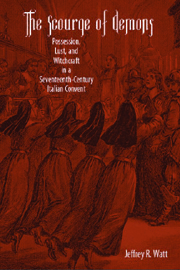Book contents
- Frontmatter
- Contents
- List of Illustrations
- Acknowledgments
- Introduction: Nuns, Witchcraft, and the Inquisition
- Chapter 1 Female Religious, Claustration, and Santa Chiara of Carpi
- Chapter 2 The Outbreak and Maleficia
- Chapter 3 The Confessor and Love Magic
- Chapter 4 The Exorcists and the Demons
- Chapter 5 Sisters Dealta and Ippolita under Attack
- Chapter 6 Bellacappa's Defense
- Chapter 7 The Waning of the Possessions
- Conclusion
- Appendix A
- Appendix B
- List of Abbreviations
- Notes
- Selected Bibliography
- Index
Chapter 7 - The Waning of the Possessions
Published online by Cambridge University Press: 12 September 2012
- Frontmatter
- Contents
- List of Illustrations
- Acknowledgments
- Introduction: Nuns, Witchcraft, and the Inquisition
- Chapter 1 Female Religious, Claustration, and Santa Chiara of Carpi
- Chapter 2 The Outbreak and Maleficia
- Chapter 3 The Confessor and Love Magic
- Chapter 4 The Exorcists and the Demons
- Chapter 5 Sisters Dealta and Ippolita under Attack
- Chapter 6 Bellacappa's Defense
- Chapter 7 The Waning of the Possessions
- Conclusion
- Appendix A
- Appendix B
- List of Abbreviations
- Notes
- Selected Bibliography
- Index
Summary
In the autumn of 1638, the Congregation of the Holy Office grew increasingly impatient with the convent's apparently never-ending unrest. In late October Cardinal Barberini wrote a letter to Archpriest Niccolini giving him detailed instructions on what to do with the afflicted nuns. He reiterated that the agitated sisters were supposed to be held in isolation from each other and forbidden to speak with or write to anyone inside or outside the convent. Fearing suicide attempts by the frenetic nuns, Barberini ordered that there be no objects in their cells with which they could do themselves harm. Sharing these fears, Inquisitor Tinti expressed his concern that there were windows in almost all the rooms in which the ailing sisters could be kept at least somewhat isolated from the others. While in their senses, the demoniac nuns asked Tinti to have the windows nailed shut out of fear that, when agitated, they might jump to their deaths into the courtyard below. The inquisitor further related that one of the nuns actually tried to jump into a well, but was restrained by others. Barberini instructed the archpriest to make sure that the ailing nuns be furnished with “holy images, holy water, and relics, which demons fear.” But the cardinal also asked Niccolini and others involved not to be so quick to believe that the chaos and bizarre behavior observed was the work of the devil, because “among women, especially nuns,” this could easily be the result of “melancholic passion” if not an outright fabrication.
- Type
- Chapter
- Information
- The Scourge of DemonsPossession, Lust, and Witchcraft in a Seventeenth-Century Italian Convent, pp. 181 - 196Publisher: Boydell & BrewerPrint publication year: 2009



